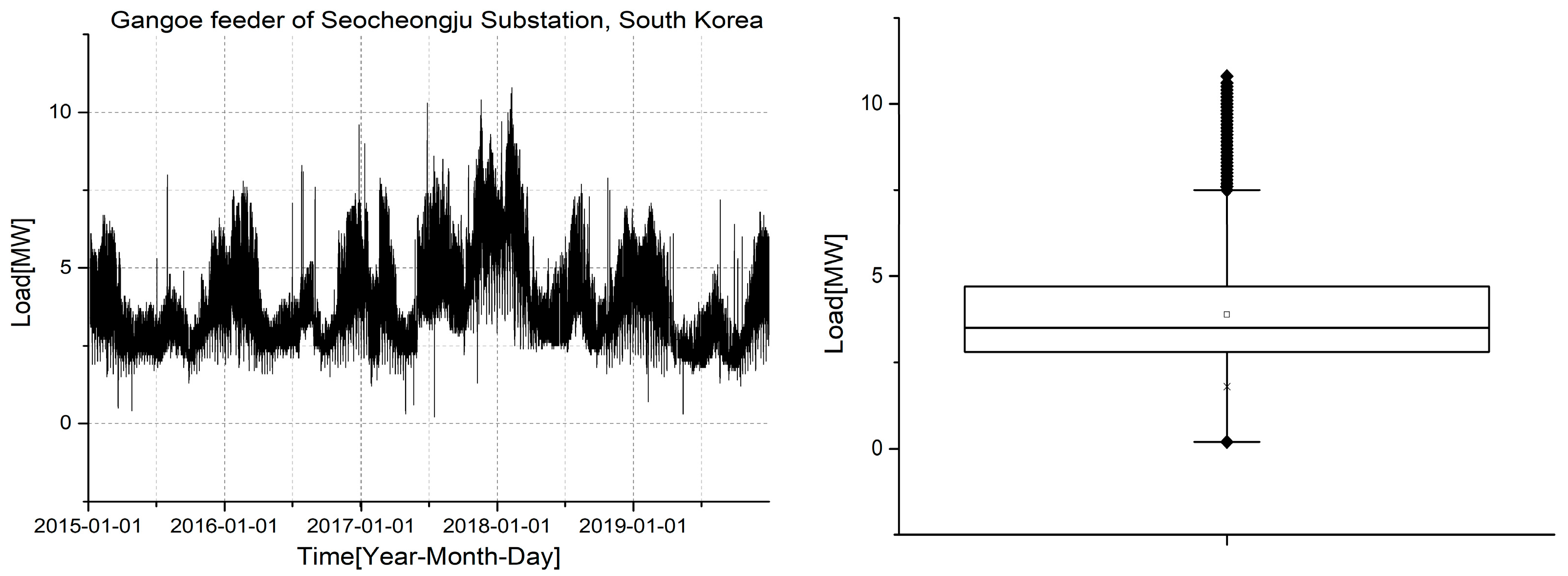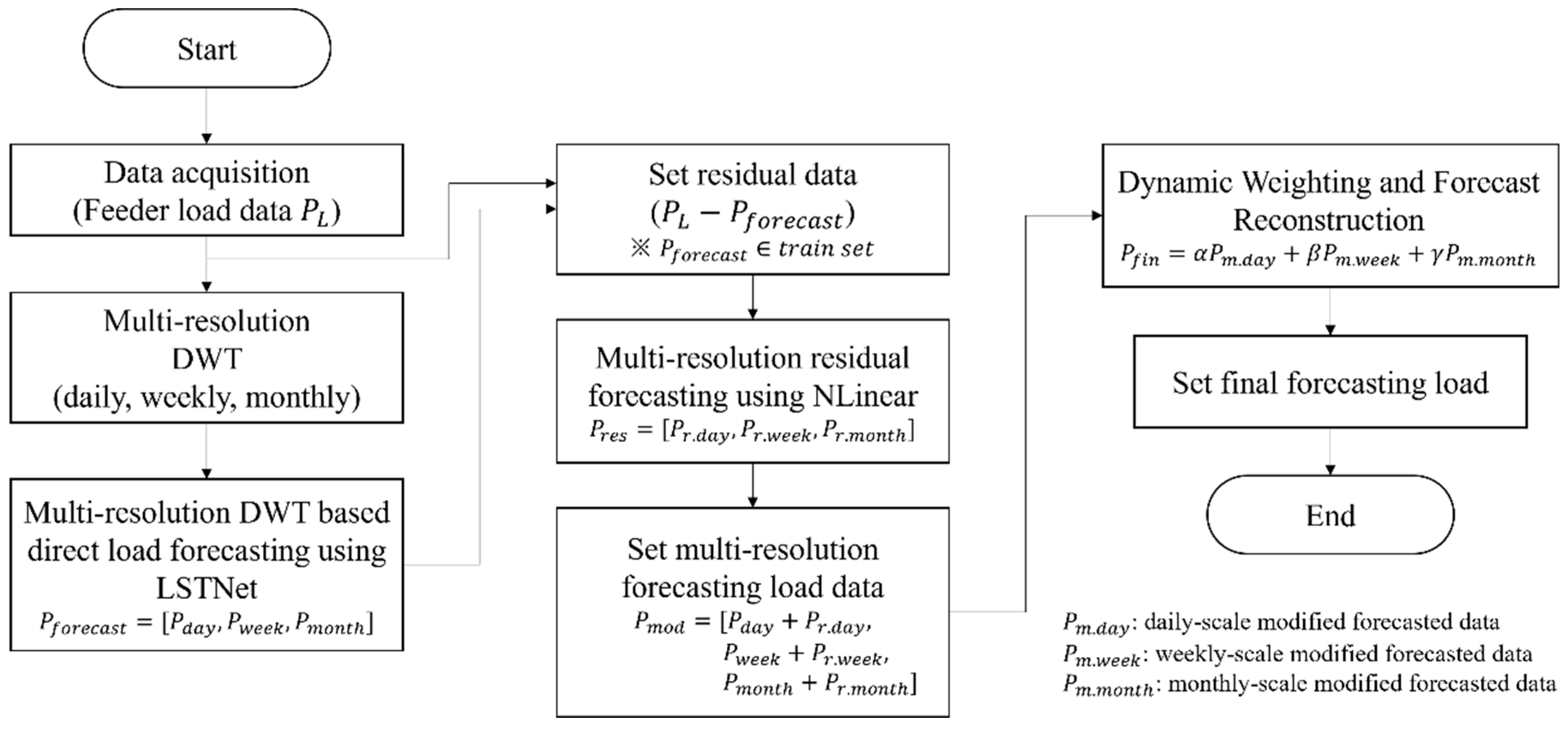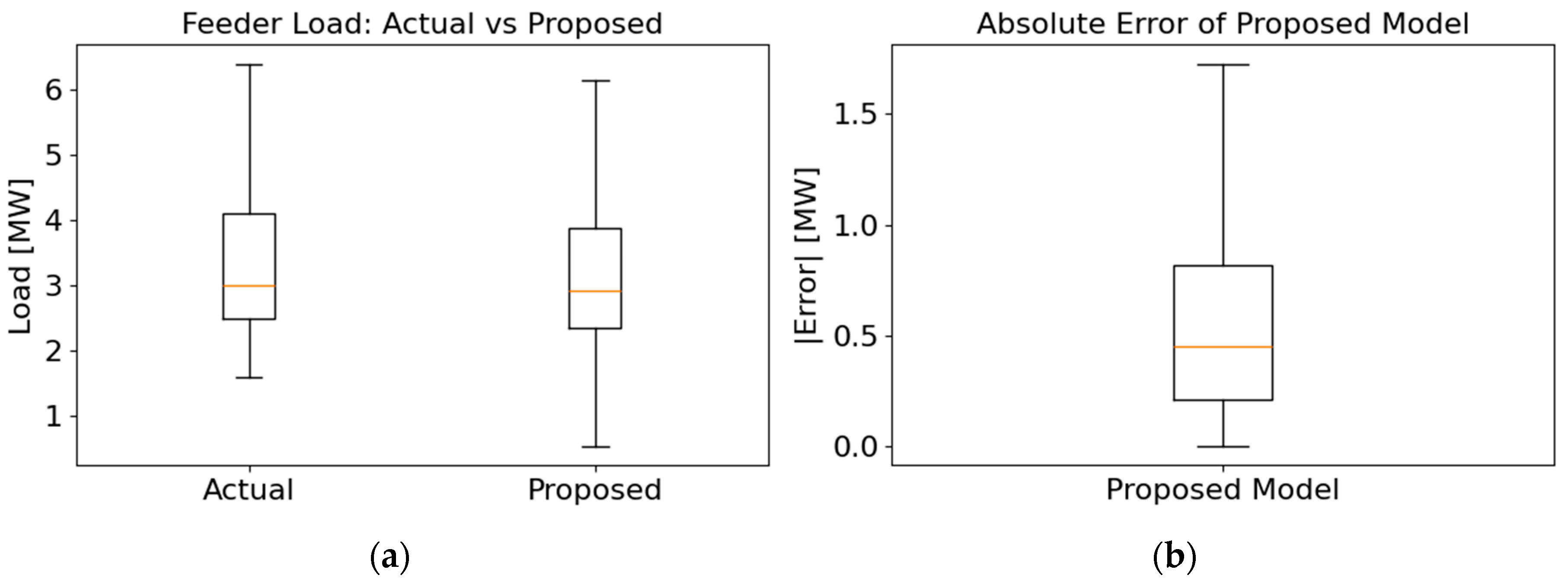Multi-Resolution LSTNet Framework with Wavelet Decomposition and Residual Correction for Long-Term Hourly Load Forecasting on Distribution Feeders
Abstract
1. Introduction
2. Data Acquisition and Description
3. Multi-Resolution Wavelet–Neural Forecasting Framework
3.1. Multi-Resolution Discrete Wavelet Transform for Load Decomposition
3.2. Direct Load Forecasting Using Multi-Resolution LSTNet
3.2.1. Direct Forecasting Method
3.2.2. LSTNet-Based Load Forecasting Architecture
3.3. Residual Learning Using NLinear
3.4. Dynamic Weighting and Forecast Integration
4. Verification of Proposed Method
5. Conclusions
Author Contributions
Funding
Data Availability Statement
Conflicts of Interest
References
- Lindberg, K.B.; Seljom, P.; Madsen, H.; Fischer, D.; Korpås, M. Long-term electricity load forecasting: Current and future trends. Util. Policy 2019, 58, 102–119. [Google Scholar] [CrossRef]
- Carvallo, J.P.; Larsen, P.H.; Sanstad, A.H.; Goldman, C.A. Long term load forecasting accuracy in electric utility integrated resource planning. Energy Policy 2018, 119, 410–422. [Google Scholar] [CrossRef]
- Zhang, D.; Guan, W.; Yang, J.; Yu, H.; Xiao, W.C.; Yu, T. Medium- and long-term load forecasting method for group objects based on image representation learning. Front. Energy Res. 2021, 9, 739993. [Google Scholar] [CrossRef]
- Mathew, A.; Chikte, R.; Sadanandan, S.K.; Abdelaziz, S.; Ijaz, S.; Ghaoud, T. Medium-term feeder load forecasting and boosting peak accuracy prediction using the PWP-XGBoost model. Electr. Power Syst. Res. 2024, 237, 111051. [Google Scholar] [CrossRef]
- Matrenin, P.; Safaraliev, M.; Dmitriev, S.; Kokin, S.; Ghulomzoda, A.; Mitrofanov, S. Medium-term load forecasting in isolated power systems based on ensemble machine learning models. Energy Rep. 2022, 8, 612–618. [Google Scholar] [CrossRef]
- Butt, F.M.; Hussain, L.; Jafri, S.H.M.; Alshahrani, H.M.; Wesabi, F.N.A.; Lone, K.J.; Din, E.M.T.E.; Duhayyim, M.A. Intelligence based accurate medium and long term load forecasting system. Appl. Artif. Intell. 2022, 36, 2088452. [Google Scholar] [CrossRef]
- Lee, G.C. A regression-based method for monthly electric load forecasting in South Korea. Energies 2024, 17, 5860. [Google Scholar] [CrossRef]
- Jung, S.M.; Park, S.W.; Jung, S.W.; Hwang, E.J. Monthly electric load forecasting using transfer learning for smart cities. Sustainability 2020, 12, 6364. [Google Scholar] [CrossRef]
- Wen, Z.; Xie, L.; Fan, Q.; Feng, H. Long term electric load forecasting based on TS-type recurrent fuzzy neural network model. Electr. Power Syst. Res. 2020, 179, 106106. [Google Scholar] [CrossRef]
- Liu, D.; Sun, K.; Huang, H.; Tang, P. Monthly load forecasting based on economic data by decomposition integration theory. Sustainability 2018, 10, 3282. [Google Scholar] [CrossRef]
- Wang, K.; Zhang, J.; Li, X.; Zhang, Y. Long-term power load forecasting using LSTM-Informer with ensemble learning. Electronics 2023, 12, 2175. [Google Scholar] [CrossRef]
- Farrag, T.A.; Elattar, E.E. Optimized deep stacked long short-term memory network for long-term load forecasting. IEEE Access 2021, 9, 68511–68522. [Google Scholar] [CrossRef]
- Rubasinghe, O.; Zhang, X.; Chau, T.K.; Chow, Y.H.; Fernando, T.; Lu, H.H.C. A novel sequence-to-sequence data modelling based CNN-LSTM algorithm for three years ahead monthly peak load forecasting. IEEE Trans. Power Syst. 2024, 39, 1932–1947. [Google Scholar] [CrossRef]
- Peng, H.; Lou, Y.; Li, F.; Sun, H.; Liu, R.; Jin, B.; Li, Y. Decomposition framework for long term load forecasting on temperature insensitive area. Energy Rep. 2024, 12, 5783–5792. [Google Scholar] [CrossRef]
- Fan, J.; Zhong, M.; Guan, Y.; Yi, S.; Xu, C.; Zhai, Y.; Zhou, Y. An online long-term load forecasting method: Hierarchical highway network based on crisscross feature collaboration. Energy 2024, 299, 131459. [Google Scholar] [CrossRef]
- Dong, M.; Shi, J.; Shi, Q. Multi-year long-term load forecast for area distribution feeders based on selective sequence learning. Energy 2020, 206, 118209. [Google Scholar] [CrossRef]
- Tai, V.C.; Tan, Y.C.; Rahman, N.F.A.; Che, H.X.; Chia, C.M.; Saw, L.H.; Ali, M.F. Long-term electricity demand forecasting for Malaysia using artificial neural networks in the presence of input and model uncertainties. Energy Eng. 2021, 118, 715–725. [Google Scholar] [CrossRef]
- Ozdemir, G. Probabilistic CDF-based load forecasting model in a power distribution system. Sustain. Energy Grids Netw. 2024, 38, 101311. [Google Scholar] [CrossRef]
- Nabavi, S.A.; Mohammadi, S.; Motlagh, N.H.; Tarkoma, S.; Geyer, P. Deep learning modeling in electricity load forecasting: Improved accuracy by combining DWT and LSTM. Energy Rep. 2024, 12, 2873–2900. [Google Scholar] [CrossRef]
- Grandón, T.G.; Schwenzer, J.; Steens, T.; Breuing, J. Electricity demand forecasting with hybrid classical statistical and machine learning algorithms: Case study of Ukraine. Appl. Energy 2024, 355, 122249. [Google Scholar] [CrossRef]
- Agrawal, R.K.; Muchahary, F.; Tripathi, M.M. Long term load forecasting with hourly predictions based on long-short-term-memory networks. In Proceedings of the 2018 IEEE Texas Power and Energy Conference (TPEC), College Station, TX, USA, 8–9 February 2018; pp. 1–6. [Google Scholar] [CrossRef]
- Zhang, S.; Liu, J.; Wang, J. High-resolution load forecasting on multiple time scales using long short-term memory and support vector machine. Energies 2023, 16, 1806. [Google Scholar] [CrossRef]
- Ge, J.; Sun, H.; Shao, W.; Liu, D.; Liu, H.; Zhao, F.; Tian, B.; Liu, S. Wavelet-GAN: A GPR noise and clutter removal method based on small real datasets. IEEE Trans. Geosci. Remote Sens. 2024, 62, 5918214. [Google Scholar] [CrossRef]
- Sarkar, T.K.; Su, C.; Adve, R.; Salazar-Palma, M.; Garcia-Castillo, L.; Boix, R.R. A tutorial on wavelets from an electrical engineering perspective. I. Discrete wavelet techniques. IEEE Antennas Propag. Mag. 1998, 40, 49–68. [Google Scholar] [CrossRef]
- Marcellino, M.; Stock, J.H.; Watson, M.W. A comparison of direct and iterated multistep AR methods for forecasting macroeconomic time series. J. Econom. 2006, 135, 499–526. [Google Scholar] [CrossRef]
- Lai, G.; Chang, W.C.; Yang, Y.; Liu, H. Modeling long- and short-term temporal patterns with deep neural networks. In Proceedings of the 41st International ACM SIGIR Conference on Research & Development in Information Retrieval (SIGIR 2018), Ann Arbor, MI, USA, 8–12 July 2018; pp. 95–104. [Google Scholar] [CrossRef]
- Li, G.; Ding, C.; Zhao, N.; Wei, J.; Guo, Y.; Meng, C.; Huang, K.; Zhu, R. Research on a novel photovoltaic power forecasting model based on parallel long and short-term time series network. Energy 2024, 293, 130621. [Google Scholar] [CrossRef]
- Shi, J.; Wang, S.; Qu, P.; Shao, J. Time series prediction model using LSTM-Transformer neural network for mine water inflow. Sci. Rep. 2024, 14, 18284. [Google Scholar] [CrossRef]
- Kumar, G.; Singh, U.P.; Jain, S. An adaptive particle swarm optimization-based hybrid long short-term memory model for stock price time series forecasting. Soft Comput. 2022, 26, 12115–12135. [Google Scholar] [CrossRef]
- Isah, A.; Shin, H.; Oh, S.M.; Oh, S.W.; Aliyu, I.; Um, T.W.; Kim, J.S. Digital twins temporal dependencies-based on time series using multivariate long short-term memory. Electronics 2023, 12, 4187. [Google Scholar] [CrossRef]
- Zeng, A.; Chen, M.; Zhang, L.; Xu, Q. Are transformers effective for time series forecasting? In Proceedings of the AAAI Conference on Artificial Intelligence, Washington, DC, USA, 7–14 February 2023; 37, pp. 11121–11128. [Google Scholar] [CrossRef]
- Shen, X.; Zhuang, J. Residual analysis-based model improvement for state space models with nonlinear responses. IEEE Trans. Emerg. Top. Comput. Intell. 2024, 8, 1728–1743. [Google Scholar] [CrossRef]
- Sheikh, M.R.; Coulibaly, P. Introducing time series features based dynamic weights estimation framework for hydrologic forecast merging. J. Hydrol. 2025, 654, 132872. [Google Scholar] [CrossRef]
- Wu, H.; Xu, J.; Wang, J.; Long, M. Autoformer: Decomposition transformers with auto-correlation for long-term series forecasting. In Proceedings of the 35th Conference on Neural Information Processing Systems (NeurIPS 2021), Virtual, 6–14 December 2021; pp. 22419–22430. [Google Scholar]








| Model | MAE [MW] | MAPE [%] | RMSE [MW] | Huber Loss [MW] |
|---|---|---|---|---|
| Proposed | 0.5771 | 17.7298 | 0.7606 | 0.2567 |
| Autoformer | 0.9392 | 33.6707 | 1.1246 | 0.5286 |
| LSTM | 0.7258 | 25.6651 | 0.8994 | 0.3514 |
| NLinear | 0.5837 | 18.6295 | 0.7973 | 0.2702 |
Disclaimer/Publisher’s Note: The statements, opinions and data contained in all publications are solely those of the individual author(s) and contributor(s) and not of MDPI and/or the editor(s). MDPI and/or the editor(s) disclaim responsibility for any injury to people or property resulting from any ideas, methods, instructions or products referred to in the content. |
© 2025 by the authors. Licensee MDPI, Basel, Switzerland. This article is an open access article distributed under the terms and conditions of the Creative Commons Attribution (CC BY) license (https://creativecommons.org/licenses/by/4.0/).
Share and Cite
Kim, W.-W.; Kim, J.-H. Multi-Resolution LSTNet Framework with Wavelet Decomposition and Residual Correction for Long-Term Hourly Load Forecasting on Distribution Feeders. Energies 2025, 18, 5385. https://doi.org/10.3390/en18205385
Kim W-W, Kim J-H. Multi-Resolution LSTNet Framework with Wavelet Decomposition and Residual Correction for Long-Term Hourly Load Forecasting on Distribution Feeders. Energies. 2025; 18(20):5385. https://doi.org/10.3390/en18205385
Chicago/Turabian StyleKim, Wook-Won, and Jun-Hyeok Kim. 2025. "Multi-Resolution LSTNet Framework with Wavelet Decomposition and Residual Correction for Long-Term Hourly Load Forecasting on Distribution Feeders" Energies 18, no. 20: 5385. https://doi.org/10.3390/en18205385
APA StyleKim, W.-W., & Kim, J.-H. (2025). Multi-Resolution LSTNet Framework with Wavelet Decomposition and Residual Correction for Long-Term Hourly Load Forecasting on Distribution Feeders. Energies, 18(20), 5385. https://doi.org/10.3390/en18205385






